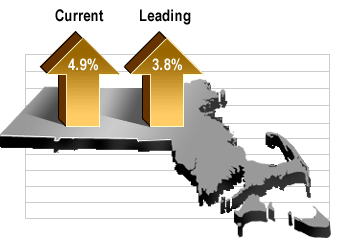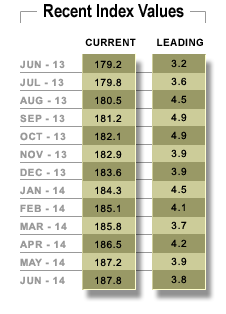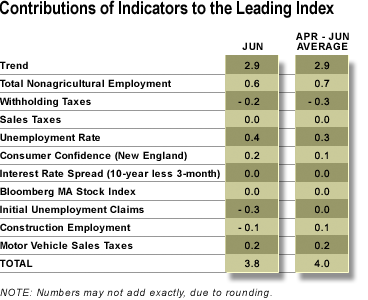Mass Economy Bounces Back in Q2 2014, UMass Journal Reports
Recent data indicate that the Commonwealth contracted slightly in first quarter
June 2014
 Massachusetts real gross domestic product grew at an estimated annual rate of 4.9 percent in the second quarter of 2014 according to the MassBenchmarks Current Economic Index, released today by MassBenchmarks, the journal of the Massachusetts economy published by the UMass Donahue Institute in collaboration with the Federal Reserve Bank of Boston. In contrast, according to the U.S. Department of Commerce, national real gross domestic product grew at an annual rate of 4.0 percent in the second quarter based on the advance estimate of the U.S. Bureau of Economic Analysis.
Massachusetts real gross domestic product grew at an estimated annual rate of 4.9 percent in the second quarter of 2014 according to the MassBenchmarks Current Economic Index, released today by MassBenchmarks, the journal of the Massachusetts economy published by the UMass Donahue Institute in collaboration with the Federal Reserve Bank of Boston. In contrast, according to the U.S. Department of Commerce, national real gross domestic product grew at an annual rate of 4.0 percent in the second quarter based on the advance estimate of the U.S. Bureau of Economic Analysis.
State and U.S. economic growth bounced back from the surprisingly weak first quarter as labor markets gained strength both locally and nationally. Based on the most recent data available, we now estimate that in the first quarter of 2014, the state's economy contracted at an estimated annual rate of 0.3 percent, while the U.S. economy declined at an annual rate of 2.1 percent. "The steep downward revision in the estimate of Massachusetts economic growth for the first quarter (originally reported as positive 2.6 percent) is primarily due to the correspondingly large downward revision in U.S. economic growth in the first quarter, originally reported as positive 0.1 percent," noted Alan Clayton-Matthews, MassBenchmarks Senior Contributing Editor and Associate Professor of Economics and Public Policy at Northeastern University, who compiles and analyzes the Current and Leading Indexes.
"The downward revisions in U.S. GDP reflect large reductions in two components — consumer spending and exports — that were most affected by the unusually harsh winter weather. This sharply lowered estimates of national and state productivity growth, meaning fewer business sales per employee and thus a significant reduction in the first quarter estimates of economic growth," Clayton-Matthews added.
 Massachusetts payroll employment grew at a 1.7 percent annual rate in the second quarter, up from 1.2 percent in the first quarter; while U.S. payroll employment grew at a 2.2 percent annual rate in the second quarter up from 1.5 percent in the first quarter. During the second quarter, the unemployment rate in Massachusetts fell from 6.3 percent (in March) to 5.5 percent (in June), while the U.S. unemployment rate fell from 6.7 percent to 6.1 percent during the same period. Year to date (through June), the state's unemployment rate has fallen 1.6 percentage points while the national unemployment rate has fallen 0.6 percentage points.
Massachusetts payroll employment grew at a 1.7 percent annual rate in the second quarter, up from 1.2 percent in the first quarter; while U.S. payroll employment grew at a 2.2 percent annual rate in the second quarter up from 1.5 percent in the first quarter. During the second quarter, the unemployment rate in Massachusetts fell from 6.3 percent (in March) to 5.5 percent (in June), while the U.S. unemployment rate fell from 6.7 percent to 6.1 percent during the same period. Year to date (through June), the state's unemployment rate has fallen 1.6 percentage points while the national unemployment rate has fallen 0.6 percentage points.
Wage and salary income declined at an 11.6 percent annual rate in the first quarter, as estimated from state withholding taxes. This does not necessarily imply a drop in regular earnings but rather it likely reflects the strong wage and salary income growth over the previous two quarters (12 to 15 percent) due to bonuses and other non-regular lump-sum wage payments. Year over year (between second quarter 2013 and second quarter 2014), total wage and salary income was up 3.4 percent.
Consumer spending in Massachusetts continued to grow strongly in the second quarter. Spending on items subject to the state's regular sales and motor vehicles sales taxes — a good proxy for consumer discretionary spending — grew at an annual rate of 7.4 percent in the second quarter, up from a 6.1 percent rate in the first quarter. By this measure, year over year (second quarter 2013 to second quarter 2014) spending on these taxable items in the Bay State has grown 7.0 percent.
The MassBenchmarks Leading Economic Index for June was 3.8 percent, and the three-month average for April through June was 4.0 percent. The leading index is a forecast of the growth in the current index over the next six months, expressed at an annual rate. Thus, it indicates that the economy is expected to grow at an annualized rate of 3.8 percent over the next six months (through December 2014).
 The 10 indicators that comprise the leading index usually do not all move in tandem. Typically, some may indicate an expectation of faster than average growth, while at the same time others may indicate an expectation of slower than average growth. The following table accounts for the contributions of each towards faster or slower growth than the trend of 2.9 percent. The index value is their sum.
The 10 indicators that comprise the leading index usually do not all move in tandem. Typically, some may indicate an expectation of faster than average growth, while at the same time others may indicate an expectation of slower than average growth. The following table accounts for the contributions of each towards faster or slower growth than the trend of 2.9 percent. The index value is their sum.
In June, four indicators contributed to a forecast of above-trend growth: total nonagricultural employment, the unemployment rate, consumer confidence, and motor vehicle sales taxes. Three indicators contributed to average-trend growth: sales taxes, the interest rate spread between 10‑year and 3‑month U.S. Treasury securities, and the Bloomberg stock index for Massachusetts. Three indicators contributed to below-trend growth: withholding taxes, initial unemployment claims, and construction employment.
In the three-month period April through June, five indicators contributed to a forecast of above-trend growth: total nonagricultural employment, the unemployment rate, consumer confidence, construction employment, and motor vehicle sales taxes. Four indicators contributed to average-trend growth: sales taxes, the interest rate spread between 10‑year and 3‑month U.S. Treasury securities, the Bloomberg stock index for Massachusetts, and initial unemployment claims. One indicator, withholding taxes, contributed to below-trend growth.
The current and historical quarterly estimates for state domestic product growth include adjustments for changes in productivity growth. These adjustments are estimates of the quarterly deviations from trend in the growth of the ratio of output to employment and output to wage and salary income. In the second quarter of 2014, these adjustments added 0.2 percentage points to the annual rate of growth. In the first quarter, these adjustments subtracted 5.3 percentage points from the annual rate of growth. For the forecast of state domestic product growth in the second and third quarters of this year, productivity growth is assumed to return to its trend.
Several recent months of the indices are revised each release. These revisions are a result of the statistical method used to create the index, as well as revisions in the underlying indicators.
--------
All of the indicators except interest rates refer to Massachusetts. The current index is composed of four indicators: nonagricultural employment, withholding taxes, sales taxes, and the unemployment rate. The leading index includes these four current indicators plus the other six (leading) indicators in the contributions table. All of the indicators are as of June, except for interest rates and the Bloomberg stock index for Massachusetts, which are through July 24th. The MassInsight Consumer Confidence Index is released every third month. Intervening months are interpolated, and changes in the Conference Board's Consumer Confidence Index for the U.S. are used to extrapolate to the current month of the index, as needed. Series measured in current dollars or values, i.e., withholding taxes, sales taxes, the Bloomberg stock index, and motor vehicle sales taxes, are deflated by the U.S. consumer price index for all urban consumers, excluding food and energy.
For a description of the methodology used to construct these indices, see: Alan Clayton-Matthews and James H. Stock, "An application of the Stock/Watson index methodology to the Massachusetts economy", Journal of Economic and Social Measurement, vol. 25 (1998/1999), pp. 183-233.
Dr. Alan Clayton-Matthews
MassBenchmarks
Northeastern University, School of Public Policy and Urban Affairs
July 30, 2014

